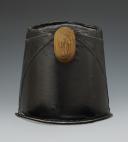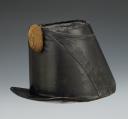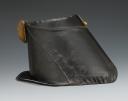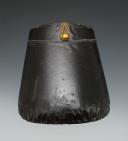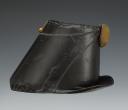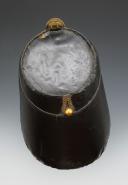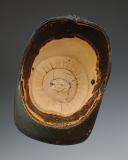
SKAKO FOR THE CAMPAIGN OUTFIT OF SECOND LIEUTENANT GASTON DE GALLIFFET OF THE GUIDES REGIMENT, circa 1855-1857, Second Empire. 27092
SKAKO FOR THE CAMPAIGN OUTFIT OF SECOND LIEUTENANT Gaston de GALLIFFET OF THE GUIDES REGIMENT, circa 1855-1857, Second Empire. 27092
Cardboard barrel and cap entirely covered with black oilcloth, H at the front 15 cm, H at the back 19 cm. Cap diameter 12 cm. Square-shaped visor with rounded corners, in black patent leather and lined with black morocco, width 4 cm, with black patent leather band folded over saddle and sewn on the outer edge; at the back in the upper part a small golden braid goes down about 3.5 cm, it is sewn to the cap and fixed by a half-bell button in golden brass in the lower part. Elliptical wooden pompom lined with daffodil canvas and covered with golden cinnamon threads, H 5.5 cm, width 3.2 cm. Inner headdress composed of a band of black patent leather gilded with three lines. Carcass lined with ivory cotton canvas marked with a pen “M de Galliffet”. At the bottom of the cap a white paper label printed in black with the name of the manufacturer is stuck “12 RUE RICHELIEU / DASSIER / Passementier Militaire / Fbsr DE S. M. L’EMPEREUR / PARIS”.
France.
Second Empire.
Very good state.
BIOGRAPHY :
Gaston de Galliffet, Marquis, Prince of Martigues, born in Paris on January 23, 1831 and died in the same city on July 9, 1909, was a French major general, Grand Cross of the Legion of Honor and military medalist.
A cavalry officer who distinguished himself during the Mexican expedition, then during the war of 1870 where he led a heroic cavalry charge at Sedan, he brutally repressed the Paris Commune in May 1871 during the Bloody Week. He subsequently participated in the reorganization of the army after the Franco-Prussian War of 1870. Commander of an army corps, and president of the Cavalry Committee of 1881 and 1885, he renovated the French cavalry and in a few years the first in Europe. Member of the Superior War Council then Minister of War in the left-wing government of Waldeck-Rousseau in 1899-1900, he followed a policy of appeasement during the Dreyfus affair.
He served brilliantly during the Crimean War in the Guides Regiment of the Imperial Guard. On June 15, 1855 he was cited in the Order of the Army as having particularly distinguished himself in the removal by force of the Russian redoubts in front of Sevastopol.
Lieutenant in 1857, he was sent to Algeria and took part in all the expeditions of the period.
He then served during the Italian campaign in 1859.
Captain in 1860 in the 2nd spahis at Mascara, he was appointed, the same year, orderly officer of the Emperor Napoleon III. He is also general councilor of the canton of Martigues (Bouches-du-Rhône).
Squadron leader on July 24, 1863 in the 1st Hussar Regiment, he served again in Algeria in Tlemcen and was promoted to officer of the Legion of Honor.
Appointed successively to the 6th hussars, then 12th hunters, he participated in the Mexican expedition and was cited in the order of the expeditionary force on April 2, 1863 as having surrendered, while he fulfilled the functions of assistant major of the trenches , services reported during the capture of the convent of Guadalupe on the night of March 31 to April 1.
On April 19, 1863 he was very seriously wounded in the stomach during the siege of Puebla in the attack against frame 29, forced to “carry his guts in his kepi” as he later recounted. Learning of his serious injury at the end of a lunch, Empress Eugénie, whose favorite he was, then, according to one of her biographers, "swore not to eat sorbets again until he was cured". He will now wear a silver plate on his stomach.
It is he who brings back to France the flags taken from the enemy. Recovered, he returned to Mexico and replaced Colonel Charles-Louis Du Pin at the head of the French counter-guerrilla. He was promoted to the rank of lieutenant-colonel on June 17, 1865 and cited once again in the order of the expeditionary force on February 24, 1867, for having given firm and intelligent impetus to all counter-guerrilla operations and having led the Medellin affair on January 7, 1867 with remarkable insight and vigor.
He was promoted on August 14, 1867 to the rank of colonel of the 3rd African Hunter Regiment.
He participated in the war of 1870 and was admitted to the 1st section of general officers with the rank of brigadier general on August 30, 1870. He commanded the brigade of African hunters (1st and 3rd regiments) of the Margueritte cavalry division which heroically charges at Sedan, at the Calvary of Illy4, to try to break the noose, earning the admiration of the King of Prussia who will pronounce a phrase that has become historic ("Ah, the brave people!"), but he is taken prisoner.
Repression of the Paris Commune
At the end of his captivity in Koblenz, he returned to France in March 1871 to command a cavalry brigade in the army of Versailles and participated in operations against the Commune where he distinguished himself by his ferocity towards the insurgents and earned the nickname of the “Marquis with red heels” or “Massacrer of the Commune” during the tragic Bloody Week. Watching the Communard prisoners pass by heading towards Versailles, "with a stick in his hand, he selects his victims in an absolutely arbitrary manner, based on their appearance." One day he ordered: “Let those who have gray hair come out of the ranks!” » ; 111 captives come forward. “You,” he said to them, “you saw June 1848, you are more guilty than the others! » ; he had them machine-gunned in the ditches of the fortifications.
Corps commander and member of the CSG
Galliffet then commanded the Batna subdivision then the 31st brigade from 1874 to 1875 and was promoted to Commander of the Legion of Honor in 1873.
Major general on May 3, 1875, he commanded the 15th Division from 1876 to 1878, then the 9th Army Corps from 1879 to 1881.
Raised to the dignity of grand officer of the Legion of Honor in 1880, he was distinguished by Léon Gambetta and named governor of Paris.
He then commanded the 12th Army Corps from 1882 to 1886.
President of the Cavalry Committee from 1881 to 1885, he reorganized the French cavalry and made it the first in Europe.
He was made the Grand Cross of the Legion of Honor on July 12, 1887.
He was a member of the Superior War Council (CSG) from 1882 to 1894 and decorated with the military medal on September 17, 1891.
He is also general inspector of the Cavalry Application School, of the cavalry section of the Special Military School and of the Armory of the War School, and permanent director of cavalry maneuvers.
Minister of War
In 1898, shortly before his appointment to the Ministry of War, he came to defend his former subordinate Marie-Georges Picquart, one of the protagonists of the Dreyfus affair, implicated before the war council12. Shortly after, it was to this retired soldier, with a sulphurous reputation, that Pierre Waldeck-Rousseau entrusted the Ministry of War in his so-called “Republican Defense” government formed on June 22, 1899 following the crisis of regime following the Affair: his republicanism and opportunism on one side, his reputation as "executioner of the Commune" on the other side, paradoxically making this character, original, hated by all sides, a reliable and ready to implement unpopular decisions for the army.
His provocative cynicism is evident in his provocative response to the left-wing deputies who greeted him as he entered the chamber by shouting “Assassin!” »: “Murderer? Here ! »
Cardboard barrel and cap entirely covered with black oilcloth, H at the front 15 cm, H at the back 19 cm. Cap diameter 12 cm. Square-shaped visor with rounded corners, in black patent leather and lined with black morocco, width 4 cm, with black patent leather band folded over saddle and sewn on the outer edge; at the back in the upper part a small golden braid goes down about 3.5 cm, it is sewn to the cap and fixed by a half-bell button in golden brass in the lower part. Elliptical wooden pompom lined with daffodil canvas and covered with golden cinnamon threads, H 5.5 cm, width 3.2 cm. Inner headdress composed of a band of black patent leather gilded with three lines. Carcass lined with ivory cotton canvas marked with a pen “M de Galliffet”. At the bottom of the cap a white paper label printed in black with the name of the manufacturer is stuck “12 RUE RICHELIEU / DASSIER / Passementier Militaire / Fbsr DE S. M. L’EMPEREUR / PARIS”.
France.
Second Empire.
Very good state.
BIOGRAPHY :
Gaston de Galliffet, Marquis, Prince of Martigues, born in Paris on January 23, 1831 and died in the same city on July 9, 1909, was a French major general, Grand Cross of the Legion of Honor and military medalist.
A cavalry officer who distinguished himself during the Mexican expedition, then during the war of 1870 where he led a heroic cavalry charge at Sedan, he brutally repressed the Paris Commune in May 1871 during the Bloody Week. He subsequently participated in the reorganization of the army after the Franco-Prussian War of 1870. Commander of an army corps, and president of the Cavalry Committee of 1881 and 1885, he renovated the French cavalry and in a few years the first in Europe. Member of the Superior War Council then Minister of War in the left-wing government of Waldeck-Rousseau in 1899-1900, he followed a policy of appeasement during the Dreyfus affair.
He served brilliantly during the Crimean War in the Guides Regiment of the Imperial Guard. On June 15, 1855 he was cited in the Order of the Army as having particularly distinguished himself in the removal by force of the Russian redoubts in front of Sevastopol.
Lieutenant in 1857, he was sent to Algeria and took part in all the expeditions of the period.
He then served during the Italian campaign in 1859.
Captain in 1860 in the 2nd spahis at Mascara, he was appointed, the same year, orderly officer of the Emperor Napoleon III. He is also general councilor of the canton of Martigues (Bouches-du-Rhône).
Squadron leader on July 24, 1863 in the 1st Hussar Regiment, he served again in Algeria in Tlemcen and was promoted to officer of the Legion of Honor.
Appointed successively to the 6th hussars, then 12th hunters, he participated in the Mexican expedition and was cited in the order of the expeditionary force on April 2, 1863 as having surrendered, while he fulfilled the functions of assistant major of the trenches , services reported during the capture of the convent of Guadalupe on the night of March 31 to April 1.
On April 19, 1863 he was very seriously wounded in the stomach during the siege of Puebla in the attack against frame 29, forced to “carry his guts in his kepi” as he later recounted. Learning of his serious injury at the end of a lunch, Empress Eugénie, whose favorite he was, then, according to one of her biographers, "swore not to eat sorbets again until he was cured". He will now wear a silver plate on his stomach.
It is he who brings back to France the flags taken from the enemy. Recovered, he returned to Mexico and replaced Colonel Charles-Louis Du Pin at the head of the French counter-guerrilla. He was promoted to the rank of lieutenant-colonel on June 17, 1865 and cited once again in the order of the expeditionary force on February 24, 1867, for having given firm and intelligent impetus to all counter-guerrilla operations and having led the Medellin affair on January 7, 1867 with remarkable insight and vigor.
He was promoted on August 14, 1867 to the rank of colonel of the 3rd African Hunter Regiment.
He participated in the war of 1870 and was admitted to the 1st section of general officers with the rank of brigadier general on August 30, 1870. He commanded the brigade of African hunters (1st and 3rd regiments) of the Margueritte cavalry division which heroically charges at Sedan, at the Calvary of Illy4, to try to break the noose, earning the admiration of the King of Prussia who will pronounce a phrase that has become historic ("Ah, the brave people!"), but he is taken prisoner.
Repression of the Paris Commune
At the end of his captivity in Koblenz, he returned to France in March 1871 to command a cavalry brigade in the army of Versailles and participated in operations against the Commune where he distinguished himself by his ferocity towards the insurgents and earned the nickname of the “Marquis with red heels” or “Massacrer of the Commune” during the tragic Bloody Week. Watching the Communard prisoners pass by heading towards Versailles, "with a stick in his hand, he selects his victims in an absolutely arbitrary manner, based on their appearance." One day he ordered: “Let those who have gray hair come out of the ranks!” » ; 111 captives come forward. “You,” he said to them, “you saw June 1848, you are more guilty than the others! » ; he had them machine-gunned in the ditches of the fortifications.
Corps commander and member of the CSG
Galliffet then commanded the Batna subdivision then the 31st brigade from 1874 to 1875 and was promoted to Commander of the Legion of Honor in 1873.
Major general on May 3, 1875, he commanded the 15th Division from 1876 to 1878, then the 9th Army Corps from 1879 to 1881.
Raised to the dignity of grand officer of the Legion of Honor in 1880, he was distinguished by Léon Gambetta and named governor of Paris.
He then commanded the 12th Army Corps from 1882 to 1886.
President of the Cavalry Committee from 1881 to 1885, he reorganized the French cavalry and made it the first in Europe.
He was made the Grand Cross of the Legion of Honor on July 12, 1887.
He was a member of the Superior War Council (CSG) from 1882 to 1894 and decorated with the military medal on September 17, 1891.
He is also general inspector of the Cavalry Application School, of the cavalry section of the Special Military School and of the Armory of the War School, and permanent director of cavalry maneuvers.
Minister of War
In 1898, shortly before his appointment to the Ministry of War, he came to defend his former subordinate Marie-Georges Picquart, one of the protagonists of the Dreyfus affair, implicated before the war council12. Shortly after, it was to this retired soldier, with a sulphurous reputation, that Pierre Waldeck-Rousseau entrusted the Ministry of War in his so-called “Republican Defense” government formed on June 22, 1899 following the crisis of regime following the Affair: his republicanism and opportunism on one side, his reputation as "executioner of the Commune" on the other side, paradoxically making this character, original, hated by all sides, a reliable and ready to implement unpopular decisions for the army.
His provocative cynicism is evident in his provocative response to the left-wing deputies who greeted him as he entered the chamber by shouting “Assassin!” »: “Murderer? Here ! »
Price :
3 500,00 €
| Destination | Envoi recommandé | Envoi Recommandé + Express |
|---|---|---|
| Shipping France | 16,00 € | 50,00 € |
| Shipping Europe | 24,00 € | 75,00 € |
| Shipping world | 60,00 € | 180,00 € |
Insurance (1%) :
35,00 €
Reference :
27092
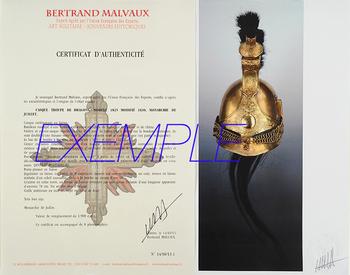
Next update Friday, april 25th at 13:30 PM
FOR ALL PURCHASES, PAYMENT IN MULTIPLE CHECKS POSSIBLE
bertrand.malvaux@wanadoo.fr 06 07 75 74 63
An authenticity certificate of the item including the description published on the site, the period, the sale price, accompanied by one or more color photographs is automatically provided for any item priced over 130 euros. Below this price, each certificate is charged 5 euros.
Only items sold by me are subject to an authenticity certificate, I do not provide any expert reports for items sold by third parties (colleagues or collectors).
